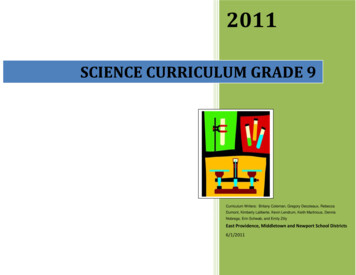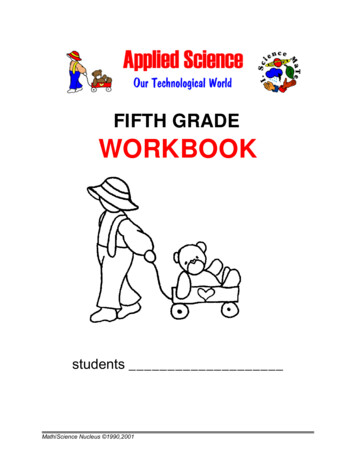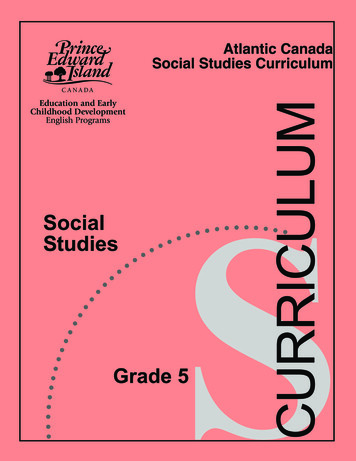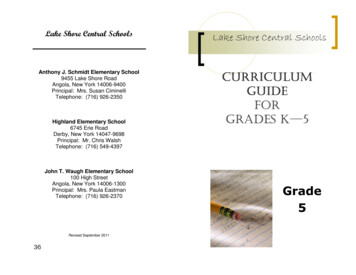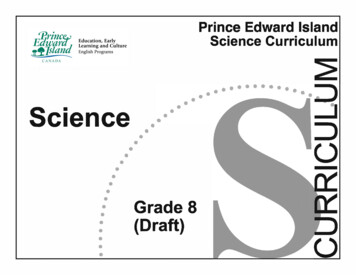
Transcription
Prince Edward IslandScience CurriculumScience Grade 8(Draft)(.)
Revised 2016Prince Edward Island Departmentof Education, Early Learningand CultureHolman Centre250 Water Street, Suite 101Summerside, Prince EdwardIsland Canada, C1N 1B6Tel: (902) 438-4130Fax: (902) 438-4062www.gov.pe.ca/eecd/
AcknowledgmentsThe P.E.I. Department of Education and Early Childhood Development expresses its gratitude to members of the provincial curriculumcommittee for their professional expertise and insights in developing this Grade 8 Science curriculum guide. In addition, the curriculumcommittee and pilot teachers who contributed comments and suggestions are to be commended for their commitment to developingexemplary science programs.Prince Edward Island Grade 8 Science Curriculum CommitteeMontague Intermediate SchoolJimmy MorrisStonepark Intermediate SchoolLinda GallantSummerside Intermediate SchoolCarl ArnoldM.E. Callaghan SchoolMary HartDepartment of Education and Early Childhood DevelopmentRoxanne HallDepartment of Education and Early Childhood DevelopmentRyan McAleerPEI DEPARTMENT OF EDUCATION AND EARLY CHILDHOOD DEVELOPMENT: GRADE 8 SCIENCEi
Table of ContentsIntroductionForeword.1Purpose .1Focus and Context.1Aim .1Scientific LiteracyVision .2Goals .2The Three Processes of Scientific Literacy.4Curriculum OutcomesFrameworkConceptual Map .6Essential Graduated Learning.7General Curriculum Outcomes .8Description of the General Curriculum Outcomes .9Specific Curriculum Outcomes .13Science K-10: At a Glance .14Key-Stage Curriculum Outcomes .16Achievement Indicators .22Blooms Taxonomy .23Table of Specifications .24Principles of Teachingand Learning ScienceExplanations, Evidence, and Models in Science.25Investigative Activities .26Design Process .27Project Based Learning .28Resources .29Education for Sustainable Development .29Technology .30Safety .31Science and Literacy.32Assessment .33Specific CurriculumOutcomesGrade 8 Science Specific Curriculum Outcomes .38Water Systems on Earth .40Fluids .46Optics .54Cells, Tissues, Organs, and Systems .60iiPEI DEPARTMENT OF EDUCATION AND EARLY CHILDHOOD DEVELOPMENT: GRADE 8 SCIENCE
IntroductionForewordThe pan-Canadian Common Framework of Science Learning Outcomes K to 12 (1997) will assist in standardizing science education across thecountry. The Prince Edward Island Department of Education and Early Childhood Development commits to align, where possible and appropriate, the scope and sequence of science education in Prince Edward Island with the scope and sequence outlined in the Common Frameworkof Science Learning Outcomes K to 12. New provincial science curriculum is also supported by the Foundation for the Atlantic Canada ScienceCurriculum (1998).PurposeThe purpose of this curriculum is to outline the provincial requirements for Grade 8 Science. This guide provides the specific curriculumoutcomes that Grade 8 students are expected to achieve in science by the end of the year. Achievement indicators and elaborations are includedto provide the breadth and depth of what students should know and be able to do in order to achieve the outcomes. This renewed curriculumreflects current science education research, updated technology, and recently developed resources, and is responsive to changing demographicswithin the province.Focus and ContextThe focus of Grade 8 Science is to introduce students to a balance of life science, physical science, and Earth and space science. The conceptsand terminology associated with Grade 8 Science will be delivered through the contexts of Water Systems on Earth, Optics, Fluids, and Cells,Tissues, Organs and Systems. Inquiry investigations and problem-solving situations create powerful learning opportunities for students. Theyincrease students’ understanding of scientific and technological concepts and help students connect ideas about their world. The Grade 8 Science program supports an interactive learning environment that encourages students to make sense of experiences through a combination of“hands-on” and “minds-on” activities.AimThe aim of science education in the Prince Edward Island is to develop scientific literacy. Scientific literacy is an evolving combination of thescience-related attitudes, skills, and knowledge students need to develop inquiry, problemsolving, and decision-making abilities; to becomelifelong learners; and to maintain a sense of wonder about the world around them. To develop scientific literacy, students require diverselearning experiences that provide opportunities to explore, analyse, evaluate, synthesize, appreciate, and understand the interrelationshipsamong science, technology, society, and the environment.PEI DEPARTMENT OF EDUCATION AND EARLY CHILDHOOD DEVELOPMENT: GRADE 8 SCIENCE1
Scientific LiteracyVisionThe Prince Edward Island science curriculum is guided by the vision that all students, regardless of gender or cultural background, will havean opportunity to develop scientific literacy. Scientific literacy is an evolving combination of the science-related attitudes, skills, and knowledgethat students need to develop inquiry, problem-solving, and decision-making abilities, to become lifelong learners, and to maintain a sense ofwonder about the world around them.GoalsConsistent with views expressed in a variety of national and international science education documents, the following goals for Canadianscience education have been established: encourage students at all grade levels to develop a critical sense of wonder and curiosity about scientific and technological endeavoursenable students to use science and technology to acquire new knowledge and solve problems, so that they may improve the quality of theirown lives and the lives of othersprepare students to address critically science-related societal, economic, ethical, and environmental issuesprovide students with a foundation in science that creates opportunities for them to pursue progressively higher levels of study, preparesthem for science-related occupations, and engages them in science-related hobbies appropriate to their interests and abilitiesdevelop in students, of varying aptitudes and interests, a knowledge of the wide variety of careers related to science and technologyWhile teachers play the most significant role in helping students achieve scientific literacy, they need support from the rest of the educationalsystem if the challenge is to be met. Science must be an important component of the curriculum at all grade levels and must be explored in anenjoyable environment that students find interesting and intrinsically rewarding. The designation of science into various categories should bediscouraged at the primary and elementary levels. At the high school level students will be introduced to the traditional sciences. These divisions are arbitrary and do not reflect current scientific practice. At all stages of science education the connections within and across the sciences, as well as the connections of science to technology, society and the environment should be stressed.2PEI DEPARTMENT OF EDUCATION AND EARLY CHILDHOOD DEVELOPMENT: GRADE 8 SCIENCE
To achieve scientific literacy for all students (K–12), the science curriculum is expected to: address the three basic scientific fields of study—life, physical, and Earth and space science. From K–10, students will beexposed to all fields. At the high school level students may optto take specific sciences. However, in all cases attempts shouldbe made to develop the connections among the basic sciences demonstrate that science is open to inquiry and controversy;promote student understanding of how we came to know whatwe know and how we test and revise our thinking utilize a wide variety of print and non-print resources developed in an interesting and interactive style. involve instructional strategies and materials which allow alllearners to experience both challenge and success incorporate assessment approaches that are aligned and correlated with the instructional program engage students in inquiry, problem solving, and decisionmaking situations and contexts that give meaning and relevance tothe science curriculum. These include the processes of sciencesuch as predicting and formulating hypotheses, higher levelskills such as critical thinking and evaluating, and manipulativeskills such as the use of laboratory equipment give students the opportunities to construct important ideas ofscience, which are then developed in depth, through inquiryand investigation be presented in connection with students’ own experiencesand interests by frequently using hands-on experiences that areintegral to the instructional sequence demonstrate connections across the curriculumStudent achievement in science and in other school subjects such as social studies, English language arts, technology, etc. is enhanced bycoordination between and among the science program and other programs. Furthermore, such coordination can maximize use of time in acrowded school schedule.PEI DEPARTMENT OF EDUCATION AND EARLY CHILDHOOD DEVELOPMENT: GRADE 8 SCIENCE3
The Three Processes of Scientific LiteracyA science education which strives for scientific literacy must engage students in asking and answering meaningful questions. Some of thesequestions will be posed by the teacher, while others will be generated by the students. These questions are of three basic types: “Why ?”“How ?” and “Should ?”. There are three processes used to answer these questions. Scientific inquiry addresses “why” questions. “How”questions are answered by engaging in the problem solving process, and “should” questions are answered by engaging in decision making.Scientific InquiryThe first of the three processes, scientific inquiry, is a way of learning about the universe. Itinvolves the posing of questions and the search for explanations of phenomena. Although thereis no such thing as a “scientific method,” students require certain skills to participate in theactivity of science. There is general agreement that skills such as questioning, observing, inferring, predicting, measuring, hypothesising, classifying, designing experiments, collecting data,analysing data, and interpreting data are fundamental to engaging in science. These skills areoften represented as a cycle which involves the posing of questions, the generation of possibleexplanations, and the collection of evidence to determine which of these explanations is mostuseful in accounting for the phenomena under investigation. Teachers should engage studentsin scientific inquiry activities to develop these skills.Problem SolvingThe second process, problem solving, seeks solutions to human problems. It is also often represented as a cycle. In this case the cycle represents the proposing, creating, and testing ofprototypes, products, and techniques in an attempt to reach an optimum solution to a givenproblem. The skills involved in this cycle facilitate a process which has different aims and different procedures from the inquiry process. Students should be given ample opportunity in thecurriculum to propose, perform, and evaluate solutions to problem solving or technologicaltasks or questions.Problem Solving Process4PEI DEPARTMENT OF EDUCATION AND EARLY CHILDHOOD DEVELOPMENT: GRADE 8 SCIENCE
Decision MakingThe third process is decision making. It is the determination of what we, as global citizens, should do in a particular context or in responseto a given situation. Increasingly, the types of problems that we deal with, both individually and collectively, require an understanding of theprocesses and products of science and technology. The actual process of decision making involves the identification of the problem or situation, generation of possible solutions or courses of action, evaluation of the alternatives, and a thoughtful decision based on the informationavailable. Students should be actively involved in decision making situations as they progress through the science curriculum. Decision makingsituations not only are important in their own right, they also often provide a relevant context for engaging in scientific inquiry and/or problemsolving.Process Involved inAnswering theQuestion:Question:Scientific inquiryTechnological problemsolvingDecision makingWhy does my coffee cool soquickly?(Science question)Heat energy is transferred byconduction, convection, andradiation.How can I make a container tokeep my coffee hot?(Technology question)A styrofoam cup will keep liquidswarm for a long time.Problems Arise from:Curiosity about events andphenomena in the natural worldCoping with everyday life,practices, and human needsTypes of Questions:What do we know?How do we know?How can we do it?Will it work?Solutions Result in:Knowledge about the events andphenomena in the natural worldAn effective and efficient way toaccomplish a taskShould we use styrofoam cups orceramic mugs for our meeting?(STSE question)Personal health, the environment,cost, and availability must beconsidered along with scienceand technology informationDifferent views or perspectivesbased on different or the sameinformationWhat alternatives orconsequences are there?Which choice is best at this time?A defensible decision in theparticular circumstancesResponse:PEI DEPARTMENT OF EDUCATION AND EARLY CHILDHOOD DEVELOPMENT: GRADE 8 SCIENCE5
Curriculum Outcomes FrameworkConceptual MapThe conceptual map below provides the blueprint of the Prince Edward Island science outcomes framework and is the basis from which general and key-stage outcomes have been developed. At all times when making use of this framework, educators must keep in mind that the outcomes are intended to develop scientific literacy in students. The outcomes in the following section are taken from the Pan-Canadian framework document Common Framework of Science Learning Outcomes K–12.Essential GraduationLearningsA Vision for ScientificLiteracyFour General re of science andInitiating and planningLife scienceAppreciation of sciencetechnologyPerforming and recordingPhysical scienceInterest in scienceRelationship betweenscience and technologyAnalysing and interpretingEarth and space scienceScience inquirySocial and environmentalCommunication and teamworkCollaborationStewardshipcontexts of science andtechnologySafetyKey-Stage Curriculum OutcomesSpecific Curriculum Outcomes6PEI DEPARTMENT OF EDUCATION AND EARLY CHILDHOOD DEVELOPMENT: GRADE 8 SCIENCE
Essential Graduated LearningThe CTE curricular program design and components are supportive of the frameworkincorporated in the Atlantic Canada Technology Education Foundation Document.Essential Graduation Learnings (EGLs) serve as a framework for the curriculum developmentprocess and are statements describing the knowledge, skills, and attitudes expected of allstudents who graduate from high school. Achievement of the EGLs will prepare students tocontinue to learn throughout their lives. These learnings describe expectations not in terms ofindividual school subjects but in terms of knowledge, skills, and attitudes developed throughoutthe curriculum. They confirm that students need to make connections and develop abilitiesacross subject boundaries if they are to be ready to meet the shifting and ongoing demands oflife, work, and learning today and in the future. EGLs are cross-curricular, and curriculum in allsubject areas is focused on enabling students to achieve these learnings.Essential Graduation LearningsEGLsGeneral Curriculum Outcomes(GCOs)broad subject expectationsSpecific Curriculum Outcomes(SCOs)for each grade levelGraduates from the public schools of Prince Edward Island will demonstrate knowledge, skills, and attitudes expressed as EGLs, and will beexpected to:respond with critical awareness to various forms of the arts and be able to express themselves through the arts; assess social, cultural, economic,and environmental interdependence in a local and global context; use the listening, viewing, speaking, reading, and writing modes of language(s),and mathematical and scientific concepts and symbols to think, learn, and communicate effectively; continue to learn and to pursue active,healthy lifestyles; use the strategies and processes needed to solve a wide variety of problems, including those requiring language, andmathematical and scientific concepts; use a variety of technologies, demonstrate an understanding of technological applications, and applyappropriate technologies for solving problems.Essential Graduation Learnings Aesthetic Expression Citizenship Communication Personal Development Problem Solving Technology CompetencyPEI DEPARTMENT OF EDUCATION AND EARLY CHILDHOOD DEVELOPMENT: GRADE 8 SCIENCE7
General Curriculum OutcomesThe general curriculum outcomes (GCO) form the basis of the outcomes framework. They constitute a starting point for the development of allsubsequent work. The also identify the key components of scientific literacy. Four general curriculum outcomes have been identified todelineate the four critical aspects of students’ scientific literacy. They reflect the wholeness and interconnectedness of learning and should beconsidered as interrelated and mutually supportive.8General Curriculum Outcome 1:General Curriculum Outcome 2:Science, technology, society, and theenvironment (STSE)—Students will developSkills and processes—Students will developan understanding of the nature of science andtechnology, of the relationships between science andtechnology, and of the social and environmentalcontexts of science and technology.the skills required for scientific and technologicalinquiry, for solving problems, for communicatingscientific ideas and results, for workingcollaboratively, and for makinginformed decisions.General Curriculum Outcome 3:General Curriculum Outcome 4:Knowledge—Students will construct knowledgeAttitudes—Students will be encouraged to developand understandings of concepts in life science,physical science, and Earth and space science, andapply these understandings to interpret, integrate,and extend their knowledge.attitudes that support the responsible acquisitionand application of scientific and technologicalknowledge to the mutual benefit of self, society, andthe environment.PEI DEPARTMENT OF EDUCATION AND EARLY CHILDHOOD DEVELOPMENT: GRADE 8 SCIENCE
Description of the General Curriculum OutcomesGCO 1: Science, technology, society, and the environment (STSE)This general curriculum outcome is the driving force of the curriculum outcomes framework. Many keystage curriculum outcomes presentedin this document flow directly or indirectly from the STSE domain. The outcome statement focusses on three major dimensions: the nature of science and technology the relationships between science and technology the social and environmental contexts of science and technologyNature of science and technologyScience provides a base used for predicting, interpreting, and explaining naturaland technological phenomena. It is oneway of knowing nature, based on curiosity,imagination, intuition, exploration, observation, replication, interpretation of evidence,and consensus making over this evidence.Science-based ideas are continually beingtested, modified, and improved as newideas supersede existing ideas. There is noset procedure for conducting a scientificinvestigation. Rather, science is driven by acombination of theories, knowledge, experimentation, and processes anchored in thephysical world.Technology, like science, is a creative humanactivity, but is concerned with solving practical problems that arise from human/socialneeds, particularly the need to adapt to theenvironment and to fuel a nation’s economy.New products and processes are producedby research and development through theprocesses of inquiry and design.Relationships between science andtechnologySocial and environmental contexts of scienceand technologyWhile there are important relationshipsbetween science and technology, there arealso important differences. Science andtechnology differ in purpose and in process.Where the focus of science is on the development and verification of knowledge; intechnology, the focus is on the developmentof solutions. The test of science knowledge isthat it helps us explain, interpret, and predict; the test of technology is that it works –it enables us to achieve a given purpose.The history of science highlights the waysin which culture has influenced the questions of science, and how science in turnhas influenced culture. Growth in STSEunderstandings may involve the followingelements: increasing complexity of scientificunderstanding - from simple to abstractideas applications in local and global contexts consideration of variables and perspectives - from simple to complex critical judgement - from simple rightand wrong assessments to complexevaluations decision making - from guided decisionsbased on limited knowledge, to independent decisions based on extensiveresearch and personal judgement.By understanding the relationships betweenscience and technology, students learn toappreciate how science and technologyinteract, how they develop in a social context, how they are used to improve people’slives, and how they have implications forthe students themselves, for others, for theeconomy, and for the environment.PEI DEPARTMENT OF EDUCATION AND EARLY CHILDHOOD DEVELOPMENT: GRADE 8 SCIENCE9
GCO 2: Skills and processesThis GCO identifies the skills and processes students develop in answering questions, solving problems, and making decisions. While theseskills and processes are not unique to science, they play an important role in the development of scientific and technological understandingand in the application of acquired knowledge to new situations. Four broad skill areas are outlined in this GCO. The listing of these skills is notintended to imply a linear sequence or to identify a single set of skills required in each science investigation. Every investigation and application of science has unique features that determine the particular mix and sequence of skills involved.As students advance from grade to grade, the skills they have developed are applied in increasingly demanding contexts. Growth in skills mayinvolve each of the following skill elements: range of application—from a limited range to a broad range of applications complexity of application—from simple, direct applications to applications that involve abstract ideas and complex interpretations andjudgements precision of measures and manipulations—from coarse measures and manipulations to those that are precise use of current and appropriate technologies and tools—from working with a few simple tools to working with a broad array of specializedand precise tools degree of independence and structure—from working under teacher guidance or in a structured situation to working independently andwithout guidance awareness and control—from following a predetermined plan to an approach involving awareness, understanding, and control, such asselecting skills and strategies that are most appropriate to the task at hand and making use of metacognition and strategic thinking ability to work collaboratively— from working as an individual to working as part of a teamInitiating and planningPerforming and recordingAnalysing and interpretingCommunication and teamworkThese are the skills of questioning, identifying problems, anddeveloping preliminary ideasand plans.These are the skills and processes of carrying out a plan ofaction, which involves gathering evidence by observationand, in most cases, manipulating materials and equipment.Gathered evidence can bedocumented and recorded in avariety of formats.These are the skills of examining information and evidence,of processing and presentingdata so that it can be interpreted, and of interpreting, evaluating, and applying the results.In science and technology, asin other areas, communicationskills are essential wheneverideas are being developed,tested, interpreted, debated,and accepted or rejected.10Teamwork skills are also important because the development and application of ideasrely on collaborative processesboth in society and in learning.PEI DEPARTMENT OF EDUCATION AND EARLY CHILDHOOD DEVELOPMENT: GRADE 8 SCIENCE
GCO 3: KnowledgeThis general curriculum outcome focuses on the subject matter of science including the theories, models, concepts, and principles that areessential to an understanding of the natural and constructed world. For organizational purposes, this GCO is framed using the widely acceptedscience disciplines - life science, physical science, Earth and space science.Life sciencePhysical scienceEarth and space scienceLife science deals with the growth and interactions of life forms within their environments in ways that reflect the uniqueness,diversity, genetic continuity, and changing nature of these life forms. Life scienceincludes the study of topics such as ecosystems, biodiversity, organisms, cell biology,biochemistry, diseases, genetic engineering,and biotechnology.Physical science, which encompasses chemistry and physics, deals with matter, energy,and forces. Matter has structure, and itscomponents interact. Energy links matter togravitational, electromagnetic, and nuclearforces in the universe. The conservation lawsof mass and energy, momentum, and chargeare addressed in physical science.Earth and space science brings global anduniversal perspectives to students’ knowledge. Earth, our home planet, exhibits form,structure, and patterns of change, as doesour surrounding solar system and the physical universe beyond. Earth and space science includes fields of study such as geology,meteorology, and astronomy.PEI DEPARTMENT OF EDUCATION AND EARLY CHILDHOOD DEVELOPMENT: GRADE 8 SCIENCE11
GCO 4: AttitudesThis general curriculum outcome focuses on encouraging students to develop attitudes, values, and ethics that inform a responsible use ofscience and technology for the mutual benefit of self, society, and the environment. Attitudes are not acquired in the same way as skillsand knowledge. They cannot be observed at any particular moment, but are evidenced by regular, unpromoted displays over time. Attitudedevelopment is a lifelong process that involves the home, the school, the community, and society at large. This GCO identifies six categories inwhich science education can contribute to the development of scientific literacy.Appreciation of scienceInterest in scienceScientific inquiryStudents will be encouraged to critically andcontextually appreciate the role and contributions of science and technology in theirlives and to their community’s culture; andto be aware of the limits of science and technology as well as their impact on economic,political, environmental, cultural, and ethical events.Students will be encouraged to develop curiosity and continuing interest in the study ofscience at home, in school, and in the community.Students will be encouraged to develop critical beliefs concerning the need for open-mindedness and flexibility, critical-mindedness and respect forevidence, initiative and perseverance, creativity and inventivenessin the development of scientific knowledge.ColloborationSafetyStewardshipStudents will be encouraged to develop attitudes that support collaborative activity.This will develop their sense of interpersonalresponsibilities, an openness to diversity,respect for multiple perspectives, and anappreciation of the efforts and contributionsof others.Students engaged in science and technologyactivities will be expected to demonstrate apositive attitude toward safety and doing noharm to themselves or others.Students will be encouraged to developresponsibility in the application of scienceand technology in relation to society andthe natural environment. They should beinvolved in activities that encourage responsible
Th e focus of Grade 8 Science is to introduce students to a balance of life science, physical science, and Earth and space science. Th e concepts and terminology associated with Grade 8 Science will be delivered through the contexts of Water Systems on Earth






